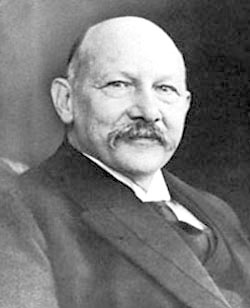April 1911: Onnes Begins work on Superconductivity
 Heike Kamerlingh Onnes |
Kamerlingh Onnes was born on September 21, 1853, in Groningen, in the Netherlands. His father owned a bricklaying business. Onnes entered the University of Groningen in 1870, spent two years in Heidelberg from 1871 to 1873, and then returned to Groningen, where he received his doctorate in physics in 1879.
Onnes, known as “the gentleman of absolute zero,” devoted his career to a quest to reach lower and lower temperatures and explore the behavior of matter at those extremely low temperatures. He began that quest in about 1882, when he joined the faculty at Leiden University and started studying low temperature gases. A dedicated experimenter, his motto was “Door meten tot weten” (“Knowledge through measurement”).
In 1898 Onnes’ rival, James Dewar, beat him in the race to liquefy hydrogen. Onnes then moved on to a new goal, liquefying helium, and this time, Onnes beat Dewar in the race, producing the first liquid helium in July 1908. Though he only liquefied a tiny amount of helium at that time, the liquefaction of helium made it possible to cool other substances to such low temperatures. Onnes managed to cool the liquid to about one degree above absolute zero, at the time the coldest temperature ever achieved.
Liquid helium was difficult to work with, so Onnes spent the next three years developing apparatus for using and storing the liquid helium for use in further studies. Rather than continuing on the quest to reach lower and lower temperatures, Onnes turned his attention to using the liquid helium to study the properties of matter near absolute zero.
In the spring of 1911, Onnes began his studies of electrical conductivity of metals at low temperature. Physicists at the time knew that resistance generally dropped as a sample was cooled, but they had no idea what happened when the temperature reached the extreme lows near absolute zero. Some had hypothesized that resistance would continue dropping slowly, finally reaching zero when the temperature reached zero. Others believed resistance would level off at some constant value. Still others, including Lord Kelvin, believed that near absolute zero electrons would essentially freeze into place and resistance would become infinite. Onnes intended to resolve the question.
Believing that any impurities in a metal would spoil his results, Onnes chose mercury for his studies because he could produce extremely pure samples of the metal. He had been working with gold at the time as well, but selected mercury instead, a fortunate choice, since had he stuck with gold he would not have discovered superconductivity.
Keeping the mercury in a U-shaped tube with wires at both ends, he passed a current through it and measured resistance as he lowered the temperature. At first, as the temperature dropped, the resistance also dropped slowly. Then, suddenly, at 4.19 Kelvin, the resistance abruptly vanished. Onnes was shocked. This was not what anyone had predicted.
At first Onnes didn’t believe what he saw; he thought perhaps there was a short circuit or some other problem with the apparatus. He and his team repeated the experiment until finally Onnes became convinced that the surprising effect was indeed real. In late April 1911, he published his first paper, titled “The resistance of pure mercury at helium temperatures” in the Communications from the Physical Laboratory at Leiden. He published a second paper in May, and in November 1911, Onnes published another paper entitled “On the Sudden Change in the Rate at which Resistance of Mercury Disappears.”
Soon after finding the effect in mercury, Onnes showed that tin and lead also become superconducting at low temperatures.
Though other physicists did not immediately grasp the importance of the discovery–a presentation Onnes gave at a conference in 1912 generated little excitement–Onnes quickly recognized the commercial potential. He predicted that someday superconducting wires would carry electricity to consumers, providing a cheap and almost unlimited supply of electricity. But Onnes was disappointed within a couple years when he discovered that a supercurrent would be destroyed by even a small magnetic field.
In 1913 Onnes first used the term “supraconductivity,” to describe the effect; later he changed it to “superconductivity.” By 1914 he had found another interesting feature: he started a supercurrent flowing in a lead wire, and a year later, found that it was still flowing, with no noticeable change.
Onnes won the Nobel Prize in 1913, just two years after his incredible discovery. He was cited for his work in low temperature physics, especially the liquefaction of helium, but not specifically for superconductivity.
Having been in delicate health for much of his life, Onnes died in 1926. For decades after Onnes’ initial discovery, no one could explain how the effect worked. Onnes himself had believed that quantum mechanics would explain the effect, but he wasn’t able to produce a theory. Finally, in 1957, Bardeen, Cooper, and Schrieffer came up with a successful theory to explain superconductivity. In 1986 Bednorz and Mueller discovered the first high temperature superconductors, a breakthrough that led to an explosion of further research and a nearly all-night conference at the APS March Meeting in 1987 known as the “Woodstock of Physics.” Superconductors are used today in levitating trains, MRI devices, in high energy physics, and in some electrical power applications.
©1995 - 2024, AMERICAN PHYSICAL SOCIETY
APS encourages the redistribution of the materials included in this newspaper provided that attribution to the source is noted and the materials are not truncated or changed.
Contributing Editor: Jennifer Ouellette
Staff Writer: Ernie Tretkoff
April 2007 (Volume 16, Number 4)
Articles in this Issue

